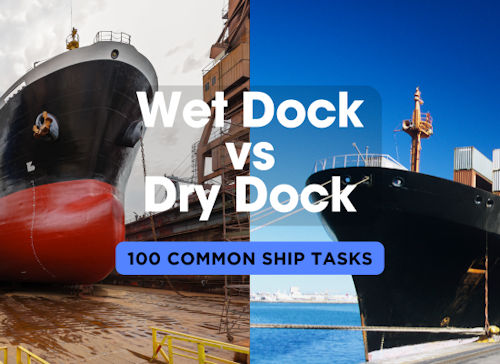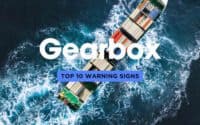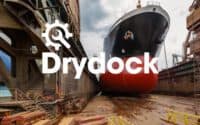Wet Dock vs Dry Dock – 100 Common Ship Maintenance/Repair Tasks

Here’s a breakdown of 100 common vessel maintenance and repair tasks, and whether it can be performed on the water. Dry docking is often necessary for intensive repairs, but it comes with a steep cost. Wet docking, on the other hand, allows you to handle routine maintenance while keeping the ship in the water, saving you a significant amount of money.
Dry Docking Costs: Typically averages $15,000 to $50,000 per day.
Wet Docking Costs: Generally much lower, ranging from $1,000 to $3,000 per day.
Table Guide: In the table below, tasks highlighted in brown usually require dry docking, while those in blue can typically be done in the water.
| Maintenance/Repair Item | Dry Dock | Wet Dock | Insights |
|---|---|---|---|
| 1. Hull cleaning | Not Required | Possible | Can be done using underwater robots or divers; essential for maintaining fuel efficiency. |
| 2. Engine oil maintenance | Not Required | Possible | Typically performed while the ship is in the water as part of routine maintenance. |
| 3. Propeller inspection and maintenance | Required | Possible | Propeller is below the waterline; dry docking is needed for comprehensive maintenance, but inspections can be done underwater. |
| 4. Rudder inspection and maintenance | Required | Possible | Rudder is below the waterline; thorough repairs need dry docking, but minor checks can be done underwater. |
| 5. Bilge pump maintenance | Not Required | Possible | Can be performed in wet dock; ensures proper bilge water management. |
| 6. Electrical system inspection | Not Required | Possible | Regular inspections can be done while the ship is in the water; crucial for operational safety. |
| 7. Fuel system inspection and cleaning | Not Required | Possible | Important for preventing fuel contamination; can be done while the ship is afloat. |
| 8. Air conditioning system maintenance | Not Required | Possible | Typically done while the ship is in the water; ensures crew comfort. |
| 9. Ballast tank inspection | Not Required | Possible | Inspections are done internally, so dry docking isn't necessary. |
| 10. Anti-fouling paint application | Required | Not Possible | Must be applied with the ship out of the water to prevent marine growth on the hull. |
| 11. Anchor chain inspection and maintenance | Not Required | Possible | Can be performed while the ship is in the water; regular inspection prevents chain failure. |
| 12. Generator maintenance | Not Required | Possible | Typically done in wet dock; ensures the generator is operational for power needs. |
| 13. Steering gear inspection and maintenance | Not Required | Possible | Can be performed in wet dock; essential for maintaining control over the vessel. |
| 14. Cooling system flush and inspection | Not Required | Possible | Regularly done in wet dock; prevents overheating of engines and other critical systems. |
| 15. Exhaust system inspection | Not Required | Possible | Can be performed while the ship is afloat; important for reducing emissions and maintaining engine efficiency. |
| 16. Life-saving equipment inspection | Not Required | Possible | Typically done in wet dock; ensures all safety equipment is functioning and compliant with regulations. |
| 17. Fire suppression system maintenance | Not Required | Possible | Can be done in wet dock; critical for onboard safety. |
| 18. Navigation equipment calibration | Not Required | Possible | Calibration is typically performed in wet dock to ensure accurate navigation data. |
| 19. Engine overhaul | Not Required | Possible | An engine overhaul involves disassembly, inspection, and replacement of key components and can often be done while the ship is in the water, provided the right facilities are available. |
| 20. Shaft alignment check | Required | Not Possible | Shaft alignment is critical for smooth operation and must be checked in dry dock to ensure accuracy. |
| 21. Valve inspection and replacement | Required | Not Possible | Valves below the waterline require dry docking for inspection and replacement. |
| 22. Deck surface maintenance | Not Required | Possible | Can be performed while the ship is in the water; involves cleaning, painting, and repairs. |
| 23. Winch inspection and maintenance | Not Required | Possible | Regular maintenance is done in wet dock to ensure the winches function properly. |
| 24. Ventilation system maintenance | Not Required | Possible | Typically performed while the ship is in the water; ensures proper air circulation onboard. |
| 25. Freshwater system inspection and cleaning | Not Required | Possible | Regular inspections ensure the system is free from contaminants; can be done in wet dock. |
| 26. Fuel system maintenance | Not Required | Possible | Performed as part of regular engine maintenance while the ship is in the water. |
| 27. Battery inspection and replacement | Not Required | Possible | Can be done while the ship is afloat; ensures reliable power supply. |
| 28. Bilge water treatment system maintenance | Not Required | Possible | Ensures the system is functioning correctly; typically done in wet dock. |
| 29. Lifeboat inspection and maintenance | Not Required | Possible | Regular inspections ensure the lifeboats are ready for use in emergencies. |
| 30. Communication equipment inspection | Not Required | Possible | Ensures reliable ship-to-shore and inter-ship communication; typically done in wet dock. |
| 31. Galley equipment maintenance | Not Required | Possible | Regular maintenance ensures safety and efficiency in food preparation areas. |
| 32. HVAC system inspection and cleaning | Not Required | Possible | Typically done in wet dock; ensures proper heating, ventilation, and air conditioning onboard. |
| 33. Watertight door inspection and repair | Required | Not Possible | Watertight doors are critical for maintaining the ship's integrity; dry docking allows for thorough inspection and repair. |
| 34. Corrosion control and rust treatment | Not Required | Possible | Can be done in wet dock, but severe cases might require dry docking; important for prolonging the ship's lifespan. |
| 35. Engine alignment check | Required | Not Possible | Ensures the engine is properly aligned to prevent vibrations and ensure smooth operation; dry docking is necessary for accuracy. |
| 36. Hull thickness measurement | Not Required | Possible | Can be done with specialized equipment while the ship is in the water, but dry docking provides more accurate results. |
| 37. Anode replacement | Not Required | Possible | Anodes can be replaced while the ship is in the water using specialized equipment or divers, ensuring continued protection against corrosion. |
| 38. Stern tube seal replacement | Required | Not Possible | Seals prevent water from entering the ship through the stern tube; replacement must be done in dry dock. |
| 39. Seacock inspection and maintenance | Required | Not Possible | Seacocks are valves below the waterline that control the intake and discharge of water; they require dry docking for inspection and maintenance. |
| 40. Void space inspection | Not Required | Possible | Typically done internally, but if structural repairs are needed, dry docking might be necessary. |
| 41. Tank cleaning (fuel, water, ballast) | Not Required | Possible | Regular cleaning ensures the integrity of fuel, water, and ballast systems; typically done in wet dock. |
| 42. Electrical wiring inspection and repair | Not Required | Possible | Performed as part of regular maintenance to ensure electrical safety and reliability; can be done in wet dock. |
| 43. Bow thruster inspection and repair | Required | Not Possible | Bow thrusters are below the waterline; inspection and repair require dry docking. |
| 44. Stabilizer fin maintenance | Required | Not Possible | Stabilizer fins are below the waterline; maintenance and repairs require dry docking for access. |
| 45. Deck machinery maintenance | Not Required | Possible | Includes winches, cranes, and other deck machinery; regular maintenance is typically done in wet dock. |
| 46. Echo sounder maintenance | Not Required | Possible | Regular calibration and maintenance can be done in wet dock to ensure accurate depth readings. |
| 47. Sonar equipment maintenance | Not Required | Possible | Typically involves cleaning and calibration, which can be done in wet dock. |
| 48. Watertight seal inspection | Required | Not Possible | Critical for maintaining the integrity of watertight compartments; inspection and replacement require dry docking. |
| 49. Sea chest maintenance | Not Required | Possible | Sea chests provide water to cooling systems; regular cleaning and inspection are typically done in wet dock. |
| 50. Paint touch-ups and repairs | Not Required | Possible | Can be done in wet dock to address minor paint damage and maintain appearance. |
| 51. Radar system maintenance | Not Required | Possible | Involves calibration and repair of radar systems; typically done in wet dock. |
| 52. Anchor windlass inspection and maintenance | Not Required | Possible | Regular maintenance ensures proper anchor handling; typically done while the ship is afloat. |
| 53. Lifeboat davit inspection | Not Required | Possible | Ensures the davits (lifeboat launching mechanisms) are operational; typically done in wet dock. |
| 54. Chain locker cleaning | Not Required | Possible | Cleaning the chain locker helps prevent corrosion and ensures proper chain stowage. |
| 55. Fuel injector cleaning and replacement | Not Required | Possible | Essential for maintaining engine performance; can be done while the ship is in the water. |
| 56. Sea water pump inspection and maintenance | Not Required | Possible | Critical for cooling systems; typically done in wet dock as part of regular maintenance. |
| 57. Bilge alarm system testing | Not Required | Possible | Ensures the bilge alarm system is functioning properly to prevent flooding; done in wet dock. |
| 58. Port and starboard light maintenance | Not Required | Possible | Essential for safe navigation; can be done in wet dock. |
| 59. Hatch cover inspection and repair | Not Required | Possible | Ensures watertight integrity of cargo holds; typically done while the ship is afloat. |
| 60. Cargo hold cleaning | Not Required | Possible | Regular cleaning prevents contamination and corrosion; done while the ship is in the water. |
| 61. Galvanic corrosion inspection | Not Required | Possible | Inspection helps prevent damage caused by dissimilar metals; typically done while the ship is afloat. |
| 62. Deck lighting inspection and repair | Not Required | Possible | Ensures proper lighting for night operations; typically done in wet dock. |
| 63. Fire door inspection and maintenance | Not Required | Possible | Fire doors are critical for compartmentalizing fires; regular maintenance is done while the ship is in the water. |
| 64. Fuel transfer pump maintenance | Not Required | Possible | Ensures the proper functioning of fuel transfer systems; maintenance is typically done in wet dock. |
| 65. Sewage treatment system inspection | Not Required | Possible | Regular inspections ensure compliance with environmental regulations; typically done while the ship is afloat. |
| 66. Engine coolant replacement | Not Required | Possible | Regular coolant replacement prevents engine overheating; typically done in wet dock. |
| 67. Crane wire rope inspection and lubrication | Not Required | Possible | Ensures the safety and efficiency of crane operations; typically done while the ship is in the water. |
| 68. Cargo hold inspection | Not Required | Possible | Inspections of cargo holds can be performed while the vessel is in the water, especially if the holds are accessible from the deck. Dry docking may be preferred for more extensive inspections or repairs. |
| 69. Hydraulic system inspection and maintenance | Not Required | Possible | Ensures proper operation of hydraulic systems; typically done while the ship is afloat. |
| 70. Autopilot system calibration | Not Required | Possible | Calibration ensures the autopilot system functions accurately; typically done in wet dock. |
| 71. Stern thruster inspection and maintenance | Required | Not Possible | Stern thrusters are below the waterline; inspection and repair require dry docking. |
| 72. Boiler inspection and maintenance | Not Required | Possible | Regular inspections ensure the boiler operates safely and efficiently; typically done in wet dock. |
| 73. Tank level gauge calibration | Not Required | Possible | Calibration ensures accurate readings of tank levels; typically done while the ship is afloat. |
| 74. Rudder stock inspection | Required | Not Possible | The rudder stock, which connects the rudder to the steering mechanism, requires dry docking for thorough inspection. |
| 75. Oily water separator maintenance | Not Required | Possible | Ensures compliance with environmental regulations; maintenance is typically done in wet dock. |
| 76. Air compressor maintenance | Not Required | Possible | Regular maintenance ensures the air compressor functions properly; typically done while the ship is afloat. |
| 77. Freefall lifeboat system inspection | Not Required | Possible | Ensures that the freefall lifeboat system is operational and ready for emergencies; typically done in wet dock. |
| 78. Waste oil disposal system inspection | Not Required | Possible | Regular inspections ensure the system operates correctly and safely; typically done while the ship is in the water. |
| 79. Steering gear oil replacement | Not Required | Possible | Ensures smooth operation of the steering gear; typically done in wet dock as part of regular maintenance. |
| 80. Life raft inspection and servicing | Not Required | Possible | Regular inspections ensure that life rafts are ready for use in emergencies; typically done while the ship is afloat. |
| 81. Main engine turbocharger maintenance | Not Required | Possible | Ensures the turbocharger is functioning efficiently, typically done while the ship is afloat. |
| 82. Heat exchanger cleaning | Not Required | Possible | Regular cleaning prevents overheating and ensures efficient operation; typically done in wet dock. |
| 83. Vessel stability assessment | Not Required | Possible | Involves calculating the vessel's stability, which can be done in wet dock or during normal operations. |
| 84. Main engine overhaul | Required | Not Possible | A comprehensive overhaul is typically done in dry dock to ensure all components are accessible and serviceable. |
| 85. Ballast water treatment system inspection | Not Required | Possible | Ensures the system complies with environmental regulations; typically done while the ship is afloat. |
| 86. Engine room ventilation cleaning | Not Required | Possible | Regular cleaning ensures proper air circulation in the engine room; typically done in wet dock. |
| 87. Cathodic protection system inspection | Not Required | Possible | Regular inspection ensures the system protects the hull from corrosion; can be done while the ship is afloat. |
| 88. Emergency fire pump testing | Not Required | Possible | Regular testing ensures the fire pump is operational in emergencies; typically done in wet dock. |
| 89. Navigation light system inspection | Not Required | Possible | Ensures the navigation lights are functioning correctly; typically done while the ship is in the water. |
| 90. Scrubber system inspection and cleaning | Required | Not Possible | Scrubber systems, used for exhaust gas cleaning, may require dry docking for thorough inspection and cleaning. |
| 91. Boiler water treatment | Not Required | Possible | Regular treatment prevents scaling and corrosion; typically done while the ship is afloat. |
| 92. CO2 firefighting system inspection | Not Required | Possible | Inspection and testing of the CO2 firefighting system can be carried out while the ship is in the water, though certain components might be easier to access during dry docking. |
| 93. Overboard discharge valve inspection | Not Required | Possible | Inspection and maintenance of overboard discharge valves can be done while the vessel is in the water, though some procedures might be more straightforward if dry docked. |
| 94. Bridge wing console maintenance | Not Required | Possible | Regular maintenance ensures the consoles on the bridge wings are operational; typically done in wet dock. |
| 95. Garbage disposal system inspection | Not Required | Possible | Regular inspections ensure compliance with waste management regulations; typically done while the ship is in the water. |
| 96. Emergency lighting system inspection | Not Required | Possible | Ensures that emergency lighting is functional; typically done in wet dock. |
| 97. Hull plating inspection & repair | Required | Not Possible | Repair of hull plating is typically done during dry docking, as it requires access to the underwater parts of the hull. Inspection is possible using underwater ROVs in easy to reach areas. |
| 98. Hatch sealing inspection | Not Required | Possible | Ensures that hatch seals are intact to prevent water ingress; typically done in wet dock. |
| 99. Deck cargo securing equipment inspection | Not Required | Possible | Regular inspection ensures that cargo securing equipment is safe and operational; typically done while the ship is afloat. |
| 100. Fuel tank vent inspection and cleaning | Not Required | Possible | Ensures that fuel tank vents are clear and functioning properly; typically done in wet dock. |

Do you have a Maritime Product or Service that may be of interest to Shipowners? Tell us about it here!
Do you have feedback or insights? Please reach out to editor @ shipuniverse.com



